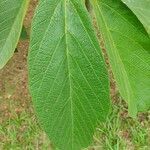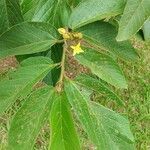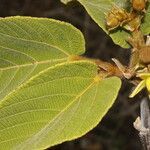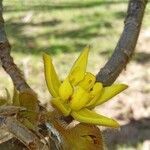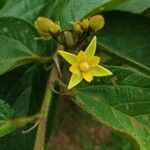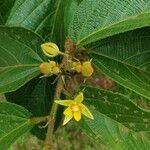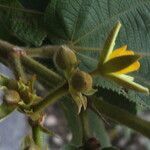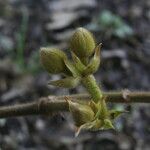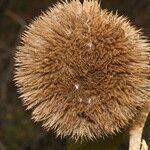Tree 6-30 m. high, the trunk 20-35 cm. or even more in diam., sometimes with small buttresses, the crown spreading, the branchlets densely hirsute. Leaves with a petiole 1.3-3 cm. long, densely long-hispid, the stipules triangular, acuminate at the apex, the margins entire or serrate, 2-3 cm. long and ca. 1 cm. wide at the base, densely scriceous without, glabrous within except the sericeous base, rather tardily deciduous; blade ovate, elliptic to oblong-elliptic, sometimes slightly obovate, cordate at the base, acute to long-apiculate at the apex, 10-33 cm. long and 5.5-15 cm. wide, firm-chartaceous, the margins serrulate, more or less rugose and rather sparsely stellate-puberulous above, densely stellate-arachnoid be-neath, 5(-7)-palminerved, the nervation prominent beneath. Inf lorescences oppositifolious, the axes covered with 2 kinds of hairs, a lower tier densely and shortly stellate-puberulous and an upper tier more or less sparsely long-hirsute, the bracts stipuliform, densely sericeous without, glabrous or nearly so within. Flowers with a pedicel 0.8-1.7 cm. long, the sepals 4-5, lanceolate to oblong-lanceolate, cucullate and acute, 1.5-2.2 cm. long and 0.5-0.4 cm. wide, fleshy, covered with 2 kinds of hairs, a lower tier densely and shortly stellate-puberulous and an upper tier sparsely long-sericeous, glabrous within; petals 4-5, spatulate to more or less obovate, rounded and somewhat emarginate, 1.1-1.6 cm. long and 0.5-0.8 cm. wide, yellow, glabrous; stamens free to slightly connate, the filaments 3.5-4.5 mm. long, sparsely long-pilose especially above, the anthers linear, ca. 3-3.5 mm. long, sparsely long-pilose especially at the base and along the margins, the appendage often bifid and ca. 1 mm. long; ovary more or less globose, somewhat depressed at both ends, ca. 3 mm. long and 4.5 mm. broad, densely and shortly hirsute, many-celled; style 0.8-1.2 cm. long, glabrous; stigma shortly denticulate.
More
A tree. It grows 20 m tall. It loses its leaves during the year. The trunk is grey ad the bark is fibrous. The leaves are simple and alternate. They are softly hairy. The leaves are are 30 cm long. They are heart shaped at the base and have teeth around the edge. The leaf stalk is swollen where it joins the leaf blade. The buds and flowers are softly hairy. The flowers are yellow. The fruit are green to brown and a flattened round shape. The fruit are 8 cm across. The fruit are covered with soft bristles. The pulp has many small seeds. The seeds are 5 mm long.
Capsule transversely elliptic, somewhat concave at the apex, ca. 4 cm. long and 7-8 cm. broad, very densely covered with long, flexible and stout bristles, these up to 1.5 cm. long and hirsute; seeds more or less globose, somewhat flattened, ca. 2.5 mm. in diam.
